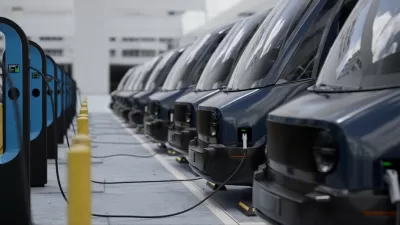Exploding global population numbers and worries about escalating energy prices, climate change, and energy independence have placed a priority on net-zero building. This article explores the viability of net-zero communities and cities.
"While some net-zero homes have been a reality for several years, it’s the commercial projects and communities that are getting the most attention as they will have a profound impact over time. The nation’s largest net-zero commercial building is located in Greater Los Angeles and was dedicated in June 2016. This 144,000 square-foot building will serve as both a living laboratory and demonstration center to showcase energy-efficient design techniques and clean energy technologies."
"Now that we know how to construct net-zero buildings, the next move is towards entire towns and cities. Perhaps a lofty goal but some communities are well on their way towards its achievement. Sacramento, CA currently has the most net-zero buildings of any city in the country. Despite this, the California state capital would have a long way to travel to reach total net-zero status as a city. However, the small community of Cambridge, MA is working on total net-zero zoning as a city. This is a long-term project that calls for a 70 percent reduction in building emissions by 2040."
"As technology and design techniques continue to improve, the net-zero movement is expected to pick up pace. While cost is a current challenge with these projects, further advances in coming years should make many of these solutions more attainable for both small and large-scale net-zero projects.
FULL STORY: Is Net-Zero Building Realistic on a Large Scale?

Maui's Vacation Rental Debate Turns Ugly
Verbal attacks, misinformation campaigns and fistfights plague a high-stakes debate to convert thousands of vacation rentals into long-term housing.

Planetizen Federal Action Tracker
A weekly monitor of how Trump’s orders and actions are impacting planners and planning in America.

In Urban Planning, AI Prompting Could be the New Design Thinking
Creativity has long been key to great urban design. What if we see AI as our new creative partner?

Cal Fire Chatbot Fails to Answer Basic Questions
An AI chatbot designed to provide information about wildfires can’t answer questions about evacuation orders, among other problems.

What Happens if Trump Kills Section 8?
The Trump admin aims to slash federal rental aid by nearly half and shift distribution to states. Experts warn this could spike homelessness and destabilize communities nationwide.

Sean Duffy Targets Rainbow Crosswalks in Road Safety Efforts
Despite evidence that colorful crosswalks actually improve intersection safety — and the lack of almost any crosswalks at all on the nation’s most dangerous arterial roads — U.S. Transportation Secretary Duffy is calling on states to remove them.
Urban Design for Planners 1: Software Tools
This six-course series explores essential urban design concepts using open source software and equips planners with the tools they need to participate fully in the urban design process.
Planning for Universal Design
Learn the tools for implementing Universal Design in planning regulations.
Appalachian Highlands Housing Partners
Gallatin County Department of Planning & Community Development
Heyer Gruel & Associates PA
Mpact (founded as Rail~Volution)
City of Camden Redevelopment Agency
City of Astoria
City of Portland
City of Laramie





























